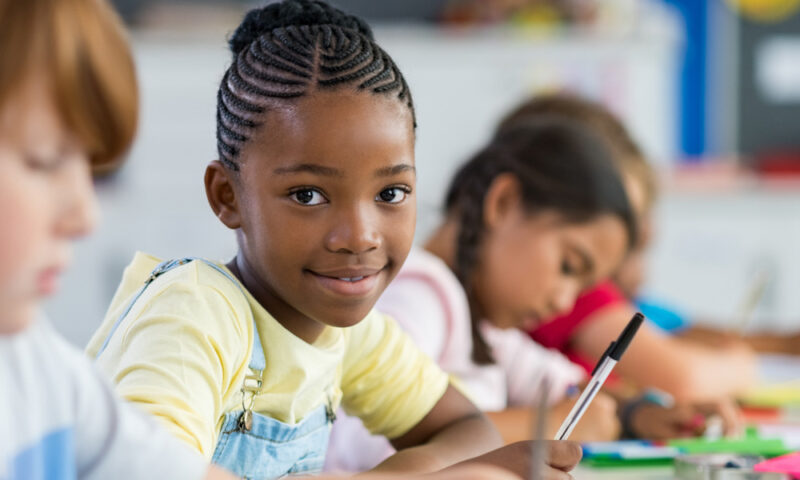Free Math Resources
Self-Assessment: Learning How to Learn
One of my favorite places to visit is London. I know that I have arrived when I see the steel and glass of the iconic London Eye. But I feel like I’ve truly arrived when I spend hours browsing the fabrics at Liberty of London’s followed by a classic British tea with scones, clotted cream, and strawberry jam. And lest I forget where I am, the blare of a horn when I don’t first look right before stepping off the sidewalk quickly reminds me that I’m in London. These are my personal touchstones for London, the ways I know that I’ve reached my journey’s end.
Just like we need ways to judge if we’ve arrived at our destination, students need to know how to determine when they’ve achieved their learning outcomes. If students don’t know where they are headed, they won’t know when they’ve arrived. Some of the ways we determine success are objective, like seeing the London Eye. Others are more personal such as spending many happy hours at Liberty’s of London. Students who actively participate in their own learning need to know how to assess their progress and determine when they have met learning criteria.
I believe that a student’s ability to effectively assess their learning is one of the most important skills we can teach. It’s a skill that students need not only to make sense of math but also to understand how they learn. And that’s the ultimate goal of education. Of course, we want students to leave school with a wide base of knowledge, but what we are all working toward is teaching students how to become lifelong learners. Self-assessment is key to achieving this objective.
The official definition of self-assessment is the “evaluation of judgment of ‘the worth’ of one’s performance and the identification of one’s strengths and weaknesses with a view to improving one’s learning outcomes.” According to John Hattie’s Visible Learning research, self-assessment yields a .75 effect size, which equals almost two years of growth in a single year.
Research shows that self-assessment has multiple benefits, including:
- Developing students’ ability to set and achieve goals
- Giving students a strong sense of self-efficacy
- Supporting greater equity for all students
- Advancing students’ ability to reason
- Developing students’ understanding of how they learn
- Increasing student engagement and motivation
- Improving students’ problem-solving skills
- Reducing math performance anxiety
- Boosting academic performance
Teaching students to self-assess takes time and practice, but it is critical if we want our students to become active, engaged learners. Students in the lower elementary grades may not be able to accurately determine if they have met learning objectives or how best to adjust course, but it’s important to begin teaching them how to assess their own learning so that as they move into the upper grades, the process is well-established. Below I outline six steps I believe are crucial to helping students become effective self-learners.
Explain why self-assessment is important. If you aren’t currently using self-assessment in your classroom, you will need to explain what it entails, why it’s important, and how you will hold students accountable. Talk about the benefits of self-assessment (noted above) in grade-appropriate language. Even if your students are already practicing self-assessment, you should regularly review the self-assessment process and why it is important.
Establish clear learning objectives. Some learning objectives will be determined by grade-level standards and others will be determined by students’ individual needs and goals. But in either case, the objectives need to be defined—students need to understand what they are supposed to learn in any lesson. In education we use rubrics, a list of criteria, against which teachers and students evaluate if the learning target has been achieved. These rubrics should be stated in child-friendly language and provide examples of what success looks like. Ideally students should be actively involved in determining some of the rubrics, particularly those that are individual to each student. Rubrics help students identify what they need to achieve, help them determine next steps, and keep them motivated through challenges.
Create a supportive classroom environment. Self-assessment requires trust. Students need to know they won’t be adversely judged when they don’t understand something or when they make mistakes. Mistakes are a vital part of the learning process, they help students pinpoint what they don’t know, allow them to correct misconceptions, and help them move forward. And of course, mistakes often drive self-assessment. Students won’t feel comfortable assessing their own work if they don’t feel comfortable making mistakes. Remember to never share students’ self-assessments without their explicit permission.
Start with past-work samples. This is a great low-stakes way to introduce students to assessment strategies. You might start with an example that models success and have students determine, using the success criteria, exactly how they know that the work example meets learning objectives. Then you can provide an example where the student didn’t meet the learning objectives. This provides you with an excellent opportunity to not only model assessment strategies but to get students actively involved in discussing what didn’t work, how they know, and what alternate strategies they might use to solve the problem. Once they have learned to respectfully and constructively assess anonymous work, they can apply those skills to their own work.
Explicitly teach self-assessment strategies. Just like you didn’t know how to effectively assess student work without learning and practicing multiple strategies, students don’t automatically know how to assess their own work. It’s important to note that in the elementary grades, self-assessment is not self-contained. Rather it often involves interaction with the teacher and with peers. Here are several self-assessment strategies you can try.
Rubrics. As I noted earlier using rubrics—a set of criteria for measuring success—is a way that educators objectively determine if students have met a particular learning target. Students in the upper elementary grades can use these same rubrics, provided they are written in grade-appropriate language, to determine if they have met each of the learning criteria. This can be as simple as a checklist.
Green, red, yellow cards. A green card indicates that students understand the material and can do the lesson or problem themselves. A yellow card signals they need a little more help. And a red card means that they find the lesson or problem difficult and need a lot of help. Students can also use thumbs up, thumbs neutral, or thumbs down. Or they can use emojis. The point is that students are determining their own level of understanding.
Peer teaching. A natural outgrowth of green, yellow, and red cards is to group students who understand the material with those who still need help. Students with green cards explain to their classmates how they approached the lesson or problem. Students learn strategies from their peers and can ask questions about what they still don’t understand. The student-teachers benefit from articulating their thoughts and processes.
Exit slips. Keep them short, two or three questions. You might ask students to rate from 1 to 5 how well they understood the lesson. Or you might ask them one thing they would like to explore more. Or what they thought they did particularly well that day. And remember, it’s not always about the math. Students may indicate that they are good listeners or that they want to improve their collaboration skills.
Goals. At the end of a lesson, week, unit, etc. have students note one goal they would like to achieve, how they will measure success, and when they will review progress. Establishing personal learning goals is essential to self-learning. Goals personalize class work and motivate students to keep going when things get hard. When students achieve goals, celebrate. If they haven’t, help them determine what adjustment they need to make to meet their goal. Just a quick note, make sure students’ goals are realistic.
Questions. Anyone who has read this blog knows I’m a big fan of asking questions. But it’s not just teachers who can pose questions, students can also ask questions of themselves. And they learn how to effectively use questions as a way of self-assessing by listening to the types of questions you ask. Could I use a different strategy? Would a particular manipulative help me better solve this problem? Is there another way I might have approached this problem? Am I at a point where I need to ask for help? Although it’s helpful for all elementary students to learn the types of questions they should ask, it’s particularly beneficial for those in grades 3–6. You might post an anchor chart in the classroom to remind students what questions to pose when they get stuck.
Journaling. Student journals provide an opportunity for students to reflect on their learning journey. They can explain their thinking, try new ideas, rethink approaches, and in general explore different ways of organizing and clarifying their thought process. Journals provide a record of growth and progress that students can see and reinforce that with effort they can improve.
Offer timely feedback. Students may not always correctly assess if they have truly mastered a skill or concept. As you listen to or read students’ self-assessments, let them know if you agree with their assessment. If you do, let them know why. If you don’t, ask questions that guide them in identifying errors, misconceptions, or better strategies and approaches.
Students who learn how to self-assess are reflective, flexible, and motivated. They are confident in their ability to learn and can make adjustments to improve their performance. They understand where they are headed and know how best to get there. In essence, they’re riding the London Eye to becoming life-long learners.
References:
Klenowski, V. 1995. Student self-evaluation processes in student-centered teaching and learning contexts of Australia and England. Assessment Education Principle Policy Practices, 145–163.
Barana, A.; Boetti, G. and Marschisio, M.. 2022. Self-assessment in the development of mathematical problem-solving skills. Education Sciences, 2022, 12, 81. https://doi.org/10.3390/educsci12020081.




